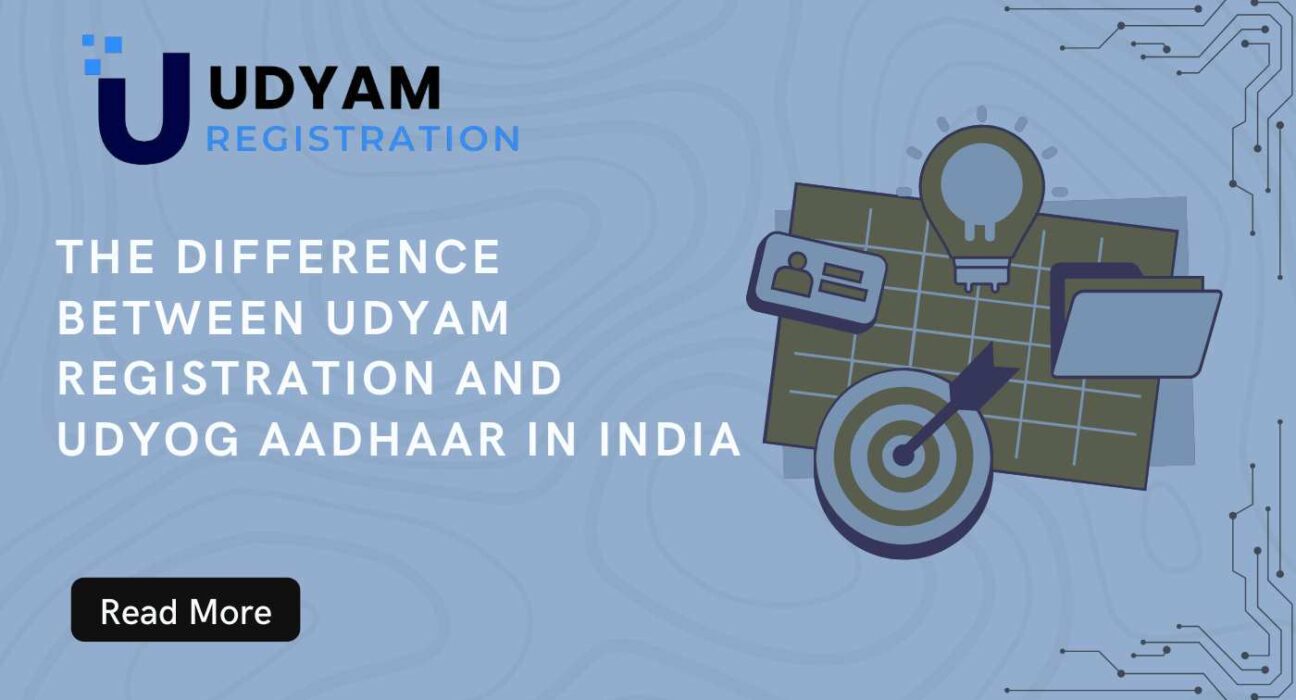Starting and running a business in India comes with its own challenges—especially when it comes to paperwork and compliance. For years, small and medium enterprises (SMEs) had to go through lengthy procedures to prove their identity and avail government benefits.
To simplify things, the Indian government introduced Udyog Aadhaar in 2015. Later, in July 2020, this system was replaced with a more advanced process called Udyam Registration.
Both systems serve the same purpose—recognizing Micro, Small, and Medium Enterprises (MSMEs)—but they are not the same. In this blog, we will clearly explain the difference between Udyam Registration and Udyog Aadhaar so that business owners can understand which one is valid today.
What Was Udyog Aadhaar?
Udyog Aadhaar was a registration process launched in 2015 under the Ministry of MSME. It provided businesses with a unique 12-digit Udyog Aadhaar Number (UAN).
The main features of Udyog Aadhaar were:
-
It was based only on Aadhaar number of the applicant.
-
Registration was free of cost.
-
MSMEs could self-declare basic details like name, type, PAN, bank account, and business activity.
-
No supporting documents were required at the time of registration.
This system was simple and easy but had some issues. Since it was based only on self-declaration, many businesses registered multiple times, and data duplication became a big challenge.
What is Udyam Registration?
In July 2020, the Government of India replaced Udyog Aadhaar with Udyam Registration Portal.
Now, every MSME must register under the Udyam system to be officially recognized. After registration, the business receives a unique Udyam Registration Number (URN) and an Udyam Certificate in digital form.
The key features of Udyam Registration are:
-
It is linked with PAN and GST, making it more transparent.
-
Registration is still free of cost.
-
Business classification is automatic, based on investment and turnover verified through GST and Income Tax databases.
-
No need to upload multiple documents—everything is verified online.
-
The Udyam Certificate does not expire; it is valid for the lifetime of the business.
This new system makes it easier for banks, government departments, and business partners to trust the information provided by MSMEs.
Key Differences Between Udyog Aadhaar and Udyam Registration
Here’s a clear comparison between the two systems:
| Feature | Udyog Aadhaar | Udyam Registration |
|---|---|---|
| Launch Year | 2015 | 2020 |
| Issuing Authority | Ministry of MSME | Ministry of MSME |
| Registration Basis | Aadhaar number only | Aadhaar + PAN + GST |
| Verification Method | Self-declaration | Automatic data verification from government databases |
| Registration Number | 12-digit Udyog Aadhaar Number (UAN) | 19-digit Udyam Registration Number (URN) |
| Certificate Validity | Lifetime, but now discontinued | Lifetime (valid for active business) |
| Document Requirement | No documents required | PAN and GST mandatory (except exempted cases) |
| Reliability | Prone to duplication and errors | Highly accurate and transparent |
Why Did the Government Replace Udyog Aadhaar with Udyam Registration?
There were several reasons:
-
Avoiding duplication of data – Under Udyog Aadhaar, the same business could apply multiple times.
-
Better classification of MSMEs – Investment and turnover data was often misreported earlier. With Udyam, this is verified from GST and Income Tax records.
-
Building trust with banks – Banks and financial institutions were hesitant to rely on Udyog Aadhaar due to errors. Udyam Registration solved this issue.
-
Ease of government schemes – Linking Udyam with PAN and GST ensures that benefits reach the right businesses.
Which One is Valid in 2025?
As of today, Udyog Aadhaar is no longer valid. All businesses that were registered under Udyog Aadhaar had to migrate to the Udyam system by 2021.
If you still have only a Udyog Aadhaar Number, you must update it to Udyam Registration immediately. Without Udyam, you cannot claim MSME benefits like:
-
Subsidies on loans.
-
Priority lending.
-
Government tenders.
-
Concessions on electricity bills and taxes.
Real Example: Migrating from Udyog Aadhaar to Udyam
Let’s take an example of Ramesh, who runs a small manufacturing unit in Pune. He had registered his business under Udyog Aadhaar in 2018. In 2022, when he applied for a loan, the bank rejected his Udyog Aadhaar certificate, saying it was no longer valid.
He approached udyamregisteration.org, a trusted platform for MSME services, and within a few days, his business was successfully migrated to Udyam Registration. With the updated Udyam Certificate, he was able to secure a loan at a lower interest rate.
This shows that updating to Udyam is not just a legal formality—it directly impacts business growth.
How to Register for Udyam (If You Still Have Udyog Aadhaar)
Here’s a step-by-step guide:
Step 1: Collect Required Information
-
Aadhaar number of business owner.
-
PAN card of business.
-
GST number (if applicable).
-
Bank details and business activity information.
Step 2: Visit the Udyam Portal
Go to the official Udyam Registration website.
Step 3: Fill in the Application Form
Enter Aadhaar, PAN, and GST details. Make sure they match your official records.
Step 4: Verification
The portal will automatically verify your details with the GST and Income Tax database.
Step 5: Get Your Udyam Certificate
Once approved, download the digital Udyam Certificate.
Benefits of Udyam Over Udyog Aadhaar
-
Greater trust from banks → faster loan approvals.
-
Automatic classification → no need to manually update turnover/investment.
-
Digital verification → no fraud or duplication.
-
Lifetime validity → no renewals required.
-
Easy access to government schemes → subsidies, credit guarantees, tenders.
Final Thoughts
The difference between Udyam Registration and Udyog Aadhaar is clear: while Udyog Aadhaar was a good step towards simplification, Udyam Registration is a much stronger, reliable, and transparent system.
Today, Udyam is the only valid MSME registration in India. If your business is still operating on Udyog Aadhaar, it’s time to upgrade immediately.
Platforms like udyamregisteration.org act as a reliable source for entrepreneurs who want to migrate smoothly or apply fresh, without errors.
In short, Udyog Aadhaar is the past, and Udyam Registration is the present and future of MSME recognition in India.





